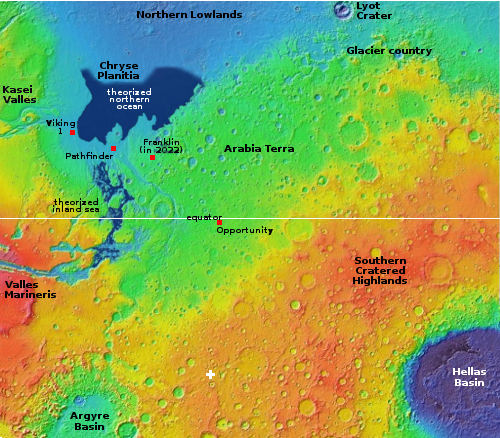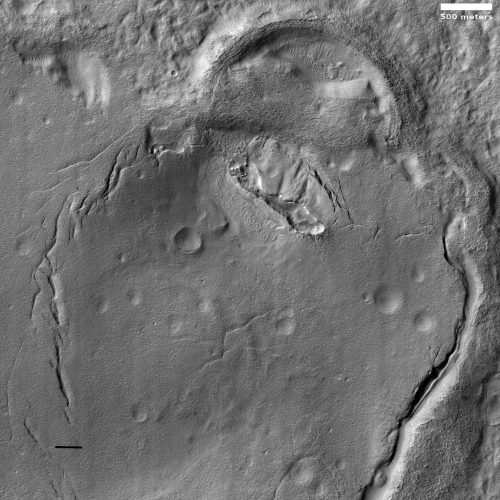Martian crater overwhelmed by glacier?
Cool image time! The photo to the right, rotated, cropped, and reduced to post here, was taken on January 28, 2022 by the high resolution camera on Mars Reconnaissance Orbiter. It shows what the science team labels a “modified crater.”
What I see is an old crater almost completely covered by glacial material. That material however is also very old, as there are numerous small craters on its surface, enough that it must have been here for a long time. Its cracked surface also suggests this glacier is very old.
Thus, while we might have ice here, buried by a thin layer of dust and debris to prevent it from sublimating away, it must be very old ice. The many climate cycles caused by the extreme swings in Mars’ rotational tilt, from 11 to 60 degrees, have apparently not caused this ice to ebb and flow very much.
Might it therefore not be ice, but hardened lava?
The location, as shown by the overview map below, provides some context, but only makes this mystery more puzzling.

The white cross indicates the location of this glacier-filled crater. Its latitude is about 40 degrees south, which places it in the southern mid-latitude bands where scientists have found a lot of ice-filled craters and glacial debris. In fact, just to the east, in the mountainous northern arc that makes up the north border of the Argyre Basin, scientists have found numerous glacial features.
So, based on this limited information, the photo appears to be showing us glacial debris. Yet if so, why has this glacier survived apparently almost unchanged while many others in the same Martian mid-latitude bands show cyclical patterns of ebb and flow, as the planet’s tilt swung back and forth?
Note too that if you click on the image and look at the full picture, the glacier that overwhelms this crater is actually filling what appears to be a much larger crater, though far more distorted along its rim. Once again, it shows no cyclical pattern, and instead appears to have sat here relatively unchanged for a very long time. The small impact craters on it also suggest that it is old, but also that whatever those impacts hit was harder than ice.
Ice or lava? Old or young? We need more information to explain this intriguing Martian geology.
On Christmas Eve 1968 three Americans became the first humans to visit another world. What they did to celebrate was unexpected and profound, and will be remembered throughout all human history. Genesis: the Story of Apollo 8, Robert Zimmerman's classic history of humanity's first journey to another world, tells that story, and it is now available as both an ebook and an audiobook, both with a foreword by Valerie Anders and a new introduction by Robert Zimmerman.
The print edition can be purchased at Amazon or from any other book seller. If you want an autographed copy the price is $60 for the hardback and $45 for the paperback, plus $8 shipping for each. Go here for purchasing details. The ebook is available everywhere for $5.99 (before discount) at amazon, or direct from my ebook publisher, ebookit. If you buy it from ebookit you don't support the big tech companies and the author gets a bigger cut much sooner.
The audiobook is also available at all these vendors, and is also free with a 30-day trial membership to Audible.
"Not simply about one mission, [Genesis] is also the history of America's quest for the moon... Zimmerman has done a masterful job of tying disparate events together into a solid account of one of America's greatest human triumphs."--San Antonio Express-News
Cool image time! The photo to the right, rotated, cropped, and reduced to post here, was taken on January 28, 2022 by the high resolution camera on Mars Reconnaissance Orbiter. It shows what the science team labels a “modified crater.”
What I see is an old crater almost completely covered by glacial material. That material however is also very old, as there are numerous small craters on its surface, enough that it must have been here for a long time. Its cracked surface also suggests this glacier is very old.
Thus, while we might have ice here, buried by a thin layer of dust and debris to prevent it from sublimating away, it must be very old ice. The many climate cycles caused by the extreme swings in Mars’ rotational tilt, from 11 to 60 degrees, have apparently not caused this ice to ebb and flow very much.
Might it therefore not be ice, but hardened lava?
The location, as shown by the overview map below, provides some context, but only makes this mystery more puzzling.

The white cross indicates the location of this glacier-filled crater. Its latitude is about 40 degrees south, which places it in the southern mid-latitude bands where scientists have found a lot of ice-filled craters and glacial debris. In fact, just to the east, in the mountainous northern arc that makes up the north border of the Argyre Basin, scientists have found numerous glacial features.
So, based on this limited information, the photo appears to be showing us glacial debris. Yet if so, why has this glacier survived apparently almost unchanged while many others in the same Martian mid-latitude bands show cyclical patterns of ebb and flow, as the planet’s tilt swung back and forth?
Note too that if you click on the image and look at the full picture, the glacier that overwhelms this crater is actually filling what appears to be a much larger crater, though far more distorted along its rim. Once again, it shows no cyclical pattern, and instead appears to have sat here relatively unchanged for a very long time. The small impact craters on it also suggest that it is old, but also that whatever those impacts hit was harder than ice.
Ice or lava? Old or young? We need more information to explain this intriguing Martian geology.
On Christmas Eve 1968 three Americans became the first humans to visit another world. What they did to celebrate was unexpected and profound, and will be remembered throughout all human history. Genesis: the Story of Apollo 8, Robert Zimmerman's classic history of humanity's first journey to another world, tells that story, and it is now available as both an ebook and an audiobook, both with a foreword by Valerie Anders and a new introduction by Robert Zimmerman.
The print edition can be purchased at Amazon or from any other book seller. If you want an autographed copy the price is $60 for the hardback and $45 for the paperback, plus $8 shipping for each. Go here for purchasing details. The ebook is available everywhere for $5.99 (before discount) at amazon, or direct from my ebook publisher, ebookit. If you buy it from ebookit you don't support the big tech companies and the author gets a bigger cut much sooner.
The audiobook is also available at all these vendors, and is also free with a 30-day trial membership to Audible.
"Not simply about one mission, [Genesis] is also the history of America's quest for the moon... Zimmerman has done a masterful job of tying disparate events together into a solid account of one of America's greatest human triumphs."--San Antonio Express-News



Oh wow! This is such a great pic. The softness of the craters in the overflowing mass suggest possible sublimation. That gash towards the center is really bizarre.
I enlarged the image, paying attention to the outfall in the crater. My impression, based on observing Earth formations, and understanding Mars is alien, is ice. It doesn’t ‘feel’ like lave, although that is a very poor way to make a judgment. Only boots on the ground will know for sure.